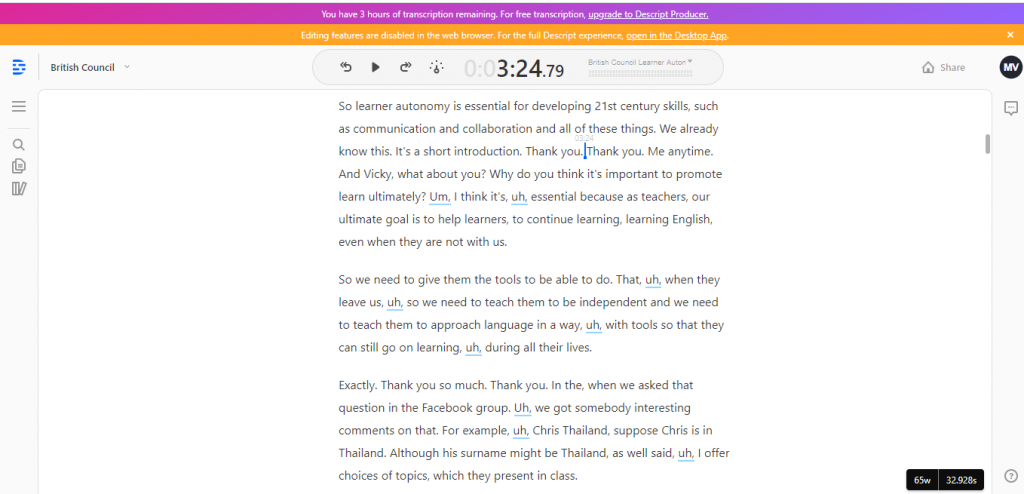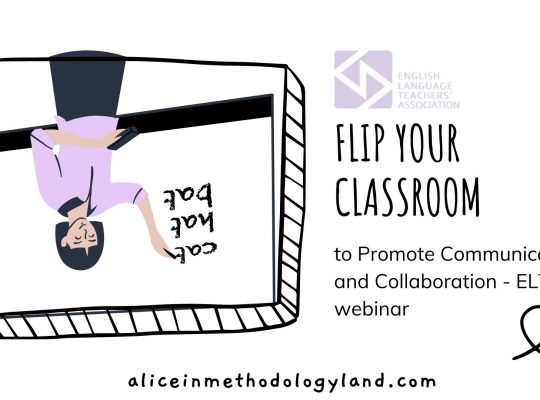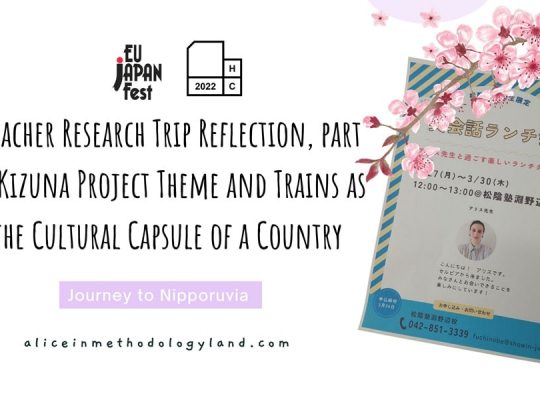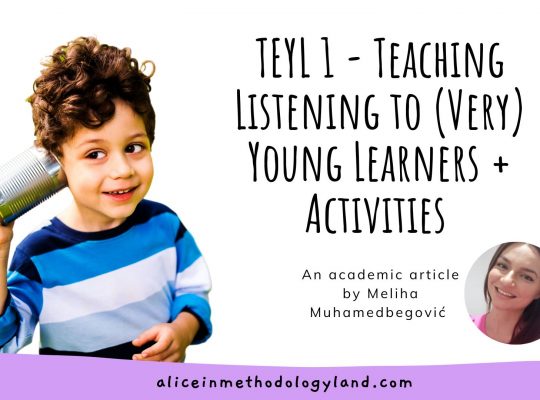Hello, my dear colleagues! I had the pleasure to be a co-presenter along with Vicky and Monika in a British Council live session about learner autonomy and young learners. The post below is a transcript of our Q and A session. Monika was the moderator and the questions the audience asked are bolded, for easier navigation. The transcription is still not perfect, but there are a lot of great ideas, so please ignore minor grammar inconsistencies. Enjoy reading/watching the session recording!
Learner autonomy and young learners Facebook live
Monika: Hello, everyone, and welcome to our Facebook live. Thank you very much for joining us today. We’ll be talking about learning autonomy. Please show your suggestions and ask the questions in the comments. My name is Monica, I’m based in Portugal, and I work for the British Council and I am on the online teacher development team. Today I’m being joined by our two guests by Vicky Saumell and Milica Vukadin. Vicky, can I please ask you to introduce yourself and tell our viewers where you are and what you do?
Vicky: Hi everybody. I am a teacher, a teacher trainer, and materials writer, conference presenter, particularly on project-based learning and the integration of learning technologies. I currently work in a primary bilingual school in Argentina, where I live, and I am the joint coordinator of the IATEFL Learning Technology SIG.
Monika: thank you, Vicky. Milica, can I ask you to introduce yourself as well, please?
Milica: Hello everybody. As you already know, my name is Milica and I come from Serbia. I’m also a teacher trainer, English teacher, and I’m currently employed as a head of language studies in an IELTS center in, Nigeria, where I develop distance learning courses. And finally, as of recently, I became a board member of the English language teacher association in Serbia.
Monika: Thank you. Let’s start with the questions!
How important is it for teachers to encourage students to learn independently? Why do you think it’s important that we promote learner autonomy?
Milica: Well, when you promote learner autonomy young learners learn independently, but before we promote learner autonomy, we really need to promote teaching autonomy and reflection in teachers. I think this is probably the biggest issue why teachers struggle with encouraging learner autonomy. Learner autonomy is essential for developing 21st-century skills, such as communication, and collaboration, and all of these things.
Monika: And Vicky, what about you? Why do you think it’s important to promote learn autonomy?
Vicky: I think it’s essential because, as teachers, our ultimate goal is to help learners to continue learning, even when they are not with us. We need to give them the tools to be able to do that. We need to teach them to be independent and we need to teach them to approach language with tools so that they can still go on learning during all their lives.
Monika: Exactly. Thank you so much. When we asked that question in the Facebook group. Uh, we got so many interesting comments on that. Chris Thailand said: I offer choices of topics, which they present in class. I teach them how to peer assess their classmates so that they understand the assessment criteria. This makes them feel involved in the assessment process. I also teach them how to use digital tools like SpeakPipe to apply the voice it’s recordings to a learning management system. They are free to record their voice as many times as they want before they are satisfied with the recording. This empowers them to take the learning into their own hands.
How do you encourage learners to interact positively? What about the learner autonomy in the remote teaching context, especially with young learners?
Monika: We have a great first question from the listeners! How do you encourage learners to interact positively? How do you give learners feedback if they are not interacting positively online? Obviously, we’re talking about learner autonomy in the remote teaching context, which is, much more challenging than the face-to-face classroom context.
Vicky: I would say that in most cases, especially young learners, are not used to being in a remote class. This is absolutely new to most learners these days. I think learner training and a code of conduct for remote teaching interactions are absolutely necessary. In our particular case, we spent the first two weeks of online live sessions teaching our students how to behave, how to interact, how to respectfully mute their microphones when somebody else was speaking, and things like that. It seems very simple, but it’s amazing how, when they learn how to do that, the class flows in a different way. And I even have very young learners, age six or seven, who know how to mute, unmute themselves, and wait for their turn to speak. I think the key is learner training in the first instances of remote teaching.
It’s fair to say that both the teachers and the learners are much wiser than we were a few months ago when the whole crisis started. We have already learned some useful tips and tricks on how to actually do it. Is there anything else that you’d like to add?
Milica: I’ve actually recently written an article for Genial.ly, which was an open letter to all students involved with distance learning classrooms. I shared some key tips for students about the distance learning process. One of them is to organize online class moderators. When you give a certain student or group of students the moderator role, they are very much involved in the process. They help other students. And then they realize that they have to be compassionate, patient, and wait because we teach them that not everybody has the same knowledge of technology. This way we are helping them become more independent, and this is a great way to teach learner autonomy to young learners.
If teaching learner autonomy to young learners is essential, how can we start doing it?
Monika: For those of you joining us today, we’re talking about learner autonomy. The next question says: ”If teaching learner autonomy to young learners is essential, how can we start doing it?” I think this is something that quite a few teachers might be struggling with, especially if they were not that keen on promoting learner autonomy in the face to the face classroom context. Uh, do we get remotely is even more challenging. So how do we start? How do we start? How do you tackle this beast? Our viewers are asking us, could you please provide some examples of the techniques or projects that you are using yourself to promote that autonomy?
Vicky: I think it starts with the teacher and, and it starts with promoting a more student-centered classroom and all that that involves in terms of how you teach language, how you present language, how you practice. if the teacher is still the center of every activity, it’s very difficult for students to become autonomous and independent. There are lots of techniques and strategies and approaches that can be more student-centered. For example, when presenting language, if you move from PPP to guided discovery, for example, students can get used to analyzing language and coming up with answers and rules, instead of you telling them the rules. If you do projects in the classroom, projects are inherently more independent than other types of work. So you’re already promoting student’s autonomy if you use certain approaches
Monika: Milica, would you like to start?
K – already know, W – want to know, L already learned!
Milica: There is a method, which is called KWL, which is basically connecting to the previous learners’ knowledge – we are doing the scaffolding method. The K stands for know – whether the students already know the content, the W stands for what do they want to know, and the L stands for what is already learned. When you connect these three steps, you can see where can you start, what is the current level of your students in any subject, not just English. You first needed to distinguish what your students already know.
Another advice would be to just talk with them. For example, as Vicki said, if you were starting to teach a new to teach with a new app or tool, you need to show students how does it work. The same goes for methods. If you’re going to promote autonomy, the students need to know why is that crucial. Why does the teacher want them to be more dependent? How is that going to help them? Then they are more involved in the process. I always do this and it actually works. Students are more involved.
How would the ways or the methods differ depending on the age of the students?
Monika: Thank you so much. In the meantime, we are getting another question. How would the ways or the methods differ depending on the age of the students? Learner autonomy, promoting learner autonomy with your primary students, and what are the ways you’re doing differently from the ways you would do it with your secondary students. How do you put the technology in the mix? How do you ignite learn autonomy in an online classroom? So you’ve got different age groups of your students and you’ve got the online learning environment. How do you do it? Vicky, would you like to start?
Vicky: Well, I would say that even though the basic principles are the same for all ages, there has to be a difference between how you approach it with different age groups. Because with adults you can go more into metacognition and things like that. Whether with younger learners, you will have to do it much more holistically, like modeling good practice more thangiving them lists of how to do’s, I think. In terms of how you introduce the technology, well, I think that technology is everywhere, so in fact, it’s not so much about forcing technology on what we are doing, but finding natural ways in which we use technology and then matching them to what we do in the classroom.
It’s how you teach that you should inform the technology that you use.
Monika: Thank you so much. Yeah, I think it’s a very important point. And it’s, again, it’s something that throughout it was a theme. It’s a theme that is sort of appearing throughout all the Facebook lives that we do. But it’s not that the chronology that should inform how you teach. It’s how you teach that you should inform the technology that you use. Milica, anything to add?
Milica: First of all, I would suggest everybody try to apply inquiry-based learning because inquiry-based learning can be applied in primary education, secondary, and even university. Also, if teachers are interested, I would suggest some TED talk videos from Sugata Mitru, the founder of the school in the cloud or SOLE sessions, in which he claimed that if you give a computer to a student and if you give them some big, open-ended questions, they can actually learn by themselves. This doesn’t mean the computer can replace teachers, of course, but it will promote learner autonomy in your young learners.
Can all secondary school learners, including the ones with special needs learn without teacher supervision?
Monika: Thank you so much. I think it’s a very important point. It’s a theme that is sort of appearing throughout all the Facebook lives that we do – It’s not that the technology that should inform how you teach, It’s how you teach that should inform the technology that you use. I still remember the massive discussion that happened in the ELT world after that presentation at the conference about the hole in the wall and the computer and lots of controversies but it’s a really, really interesting topic. We have a question that is supposed to be a bit tricky. Can all secondary school learners, including the ones with special needs learn without teacher supervision? I think it’s a wider question. Can they learn without teacher supervision? Is that all learner autonomy?
Vicky. That’s a very interesting question, really. I think that indeed students could learn on their own, but that would take the ultimate degree of intrinsic motivation to get them going. What happens when a teacher is involved is that the teacher can speed up this process of learning by finding the right things to trigger a student’s motivation. I wouldn’t say students should be left on their own. I would say the ultimate goal is that, when there is not a teacher available, they can still go on learning. But a teacher supporting the learning process will certainly make the process more effective.
Milica: We cannot abandon the students and just tell them to study by themselves because that’s not what autonomy is about. They definitely need some support, probably more support then than other students. It is very individual. Every single student has their own specific individual needs. This is a very wide question and we just can’t give a very specific answer. That’s the problem.
When adapting coursebook activities and tasks to encourage learner autonomy in young learners, what do you keep in mind?
Monika: Thank you so much! You mentioned the word moderator because this was something I noticed in the comments as well that someone said that they liked the idea of a moderator. Are you ready for the next question? When adapting coursebook activities and tasks to encourage most student account autonomy, what do you keep in mind?
Milica: Well, it is pretty hard for me to answer this question because I am more involved with informal education. I am not constricted by a textbook, but what I can say from, this informal, educator’s side is that you should try to use some hint cards.
You have a hint card, then a student can, open this card and say, okay, I don’t understand or I have an idea, what can I do next? If you’re creating these kinds of cards or you can use post-it notes. If you have a textbook, it is not always important to go from unit one to unit two, you can try to, to just change it a little bit, make a choice board. It can be interactive and online or it can be a real board. I call this pretend choice because the students are choosing from what we gave them to select, but in the eyes of a student, it is still a choice.
The importance of instructions for learner autonomy
Vicky: Well, first of all, I’m sorry if I overlap somehow, I’m not able to hear Milica when she’s speaking. What I think is really important are instructions. The instructions are sometimes very complex, and so students have to go back to the teacher to ask what they have to do because they don’t understand. Make an instruction simple enough for students to be able to follow on the road and making the steps of what they have to do. Very clear, visually clear if you have a handout, for example, separating stages so that students can really work on their own and learn how to work on their own without having to resort to the teacher all the time. Understanding the instructions immediately will definitely help young learners with the development of learner autonomy.
Milica: I just remembered one more practical tip – functional language posters. This is what I created for some of my Polish students because we have words in the textbook such as compare, contrast, listen, repeat, play, say, mimic. If we create a poster with these functional words, we are going to prevent students from asking the same things all over again and include students in the poster creation so that they actually the ones who are creating this poster. As Vicky said, they can function very well, both in the physical classroom and in the remote teaching context as well.
How should remote learning autonomous lesson plans look like?
Monika: How should remote learning autonomous lesson plans look like?
Milica: Well, I’m actually wondering, can I send you a link to such an interactive online activity? For example, another thing that I do is, uh, create interactive lessons in Genial.ly. These activities could be able to be conducted in the lesson, and also independently. For example, I can use the same interactive lesson and then give it to students who are not present and they’re going to be able to use it by themselves. If we have primary students, I often put the full translation of the instructions. It is very interactive. They have to click, to write a little, they even have something to download. These kinds of autonomous lesson plans should be in the form of interactive, mixed media that can be used both in the class and outside of the lesson – online and offline.
Monika: Thank you. Vicki, anything to add?
Vicky: Well I think that when you’re doing remote sessions, it’s the same… I mean, this should be a parallel to the face to face classroom. And the kinds of techniques used in a face to face classroom to promote autonomy should also work in the remote classroom. If you’re using live sessions, they use of breakout rooms too, to help separate sessions with smaller groups working autonomously is one way of not being all together to do work.
So maybe, proposing an activity in the first 10 minutes of class with the whole class, and then having them go to breakout rooms and working autonomously, and then coming back together for presentations or telling what they did or something like that can work really well. Again, what you would need is very clear instructions or a checklist of things they have to do while they are on breakout sessions so that time is no wasted but doing exactly what you want them to do.
Where does the learning autonomy stand in terms of assessment with young and teenage learners?
Monika: Thank you, Vicki. Actually, quite a few of our viewers are mentioning that clear instructions are vital, which might seem like a bit of a sort of dichotomy. Because we’re talking about learning autonomy, and then we’re saying, but the instructions have to be very clear. Where does the learning autonomy stand in terms of assessment?
Vicky: Well, I think there are two things to say. The first one is that it’s up to the teacher if the teacher can make such a decision, or the institution to decide whether learner autonomy will be part of the assessment, because even if I think it is the ultimate goal to produce autonomous learners, maybe it’s not something you want to assess. So that’s one possibility: you leave learner autonomy out of the assessment.
And the other is, if you do want to assess learner autonomy, then the criteria for assessment have to be very clear and transparent to students. So the students should know what we are going to be assessing in terms of how to label them autonomous learners. So, I don’t know, “can work on their own”, “use a dictionary effectively”. The set of criteria for assessing autonomy has to be very clear for both the teachers and the students.
Monika: Anything else to add to assessment?
Milica: Rubrics are very important, but also, I just want to tell you that when you’re working online and you really need to focus on formative assessment and formative assessment has this automatic autonomy. Try not to just grade students, try to give them interactive activities. I will send you a Padlet link with formative assessment activities which can be done both online and offline. They are also translated to Spanish so that educators who are teaching in Spanish can help their young learners and promote learner autonomy.
Achieving teacher autonomy
Monika: There’s also Spanish translation in these activities, so perfect. That we’re covering half of the world already with it! Thank you so much. Is there something you want to add for the end?
Vicky: The teacher is the model, so you have to model good practice, and not just say, you just have to walk your talk and model good practice. That’s the best thing we can do for all learners. Thank you so much.
Milica: Well, just as Vicky said, we really need to set an example. For me, the path to my teaching autonomy was reflection, reflection, and reflection, and also writing a lot about what I do, and collaborating with colleagues. Since I am very interested in theory, I can suggest that you read something from Kumaradivelu. He talks about post-method pedagogy, which is a way for you to develop autonomy as a teacher, and then you can reuse that to develop autonomy in students.
Monika: Thank you so much for sharing all your expertise and for giving our viewers the tricks of the trade. I can really see looking at the comments that our viewers are really appreciating everything that you’ve shared with them today. Thank our behind the scenes team that is making the magic possible- Ann, Marcus, and Graham.
A tool used for the automatic transcription
The website I used for automatic transcription is descript.com. It transcribes the text with a 95% accuracy (which means that you still need to read and edit crutch words and punctuation), but it is still amazing and it can save you a lot of time. The website offers 3 hours of free transcription, so you can

Q and A recording: Learner autonomy with young and teenage learners
A bit about bout my dear co-presenter
Vicky Saumell is a teacher, trainer, materials writer, and presenter. She holds a degree in Spanish-English Literary and Technical Translation, a Diploma in the Theory and Methodology of TESOL, and a degree in Educational Technology. Vicky has worked as a writer and trainer for Pearson, CUP, Macmillan, and Santillana, especially in the areas or project-based learning and the meaningful use of technology for language learning. She is the IATEFL LTSIG Joint Coordinator and works in a primary bilingual school in Buenos Aires, Argentina.
- Website
- Facebook Page
- Twitter @vickysaumell
- Instagram @vickys16
We hope you enjoyed this British Council live session about learner autonomy and young learners. How do you promote learner autonomy in your young learners? What are some difficulties you encountered so far? Are there some effective activities you would like to share? Write in the comments, or via the contact page. I would love to hear your opinion!

Click here to explore my store where 99% of materials are forever free!
All the materials except lesson plans and 30+ page interactive activity books will be free FOREVER! Why? Because sharing is caring, and 2020 hasn’t been kind to all of us. Please consider donating so I can keep making FREE materials for everyone and keep my website open for all of you.
Don’t forget to leave a review when you download materials! It’s just a minute of your time and it means a lot to me.
P.S. The store and the freebie library are not the same thing – the freebie library has some extra materials like conference presentations and webinar recordings which are not available in the store ✨
The subscription link for the store is below my bio in every post. ?







